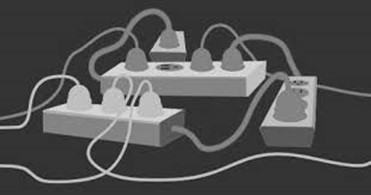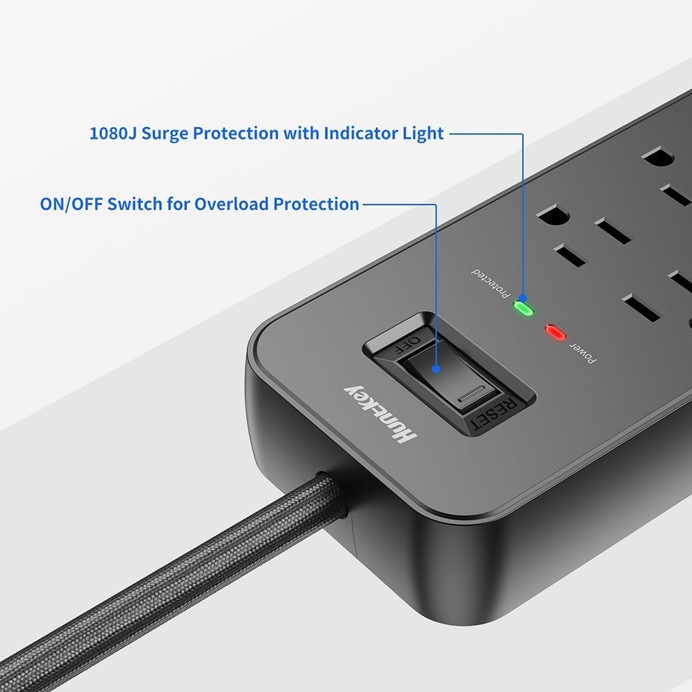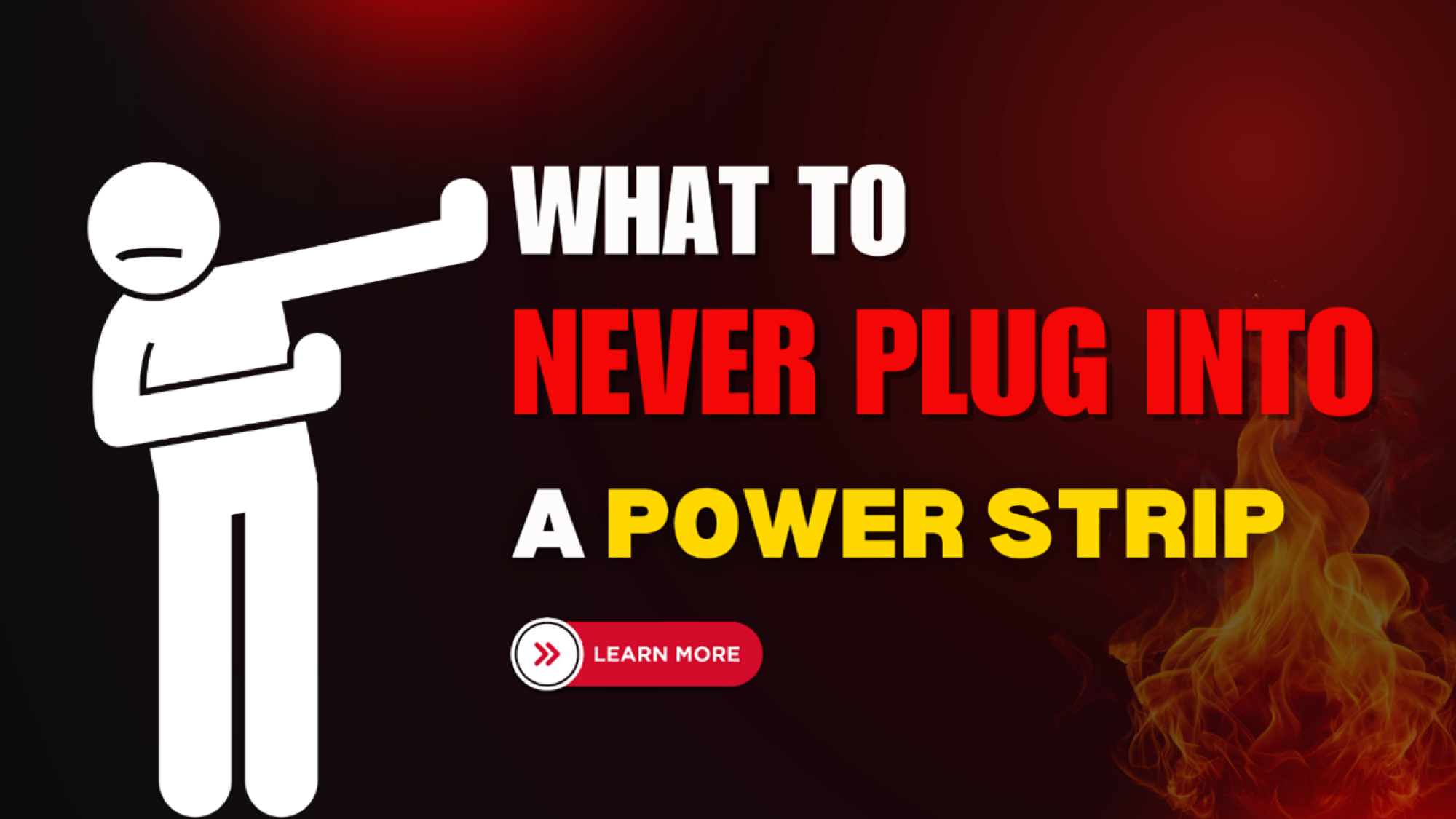Power strips are complete lifesavers. One wall outlet? No problem! Plug in a power strip and suddenly you have enough spots for your laptop, phone charger, desk lamp, and more. They're incredibly convenient for decluttering cords and getting power where you need it.
But here’s the crucial part: this convenience often makes us overlook the serious risks of misusing them. Every day 6 ft power strip can quickly turn into a dangerous fire hazard if you're not careful.
Before you plug in another device, take a moment. Do you know what absolutely shouldn't be plugged into a power strip? Let’s dive into the practical do's and don'ts to keep your home safe and powered up, the right way.
What NOT to Plug into a Power Strip: The Absolute No-Go List
So, you've got your handy 6 ft power strip, ready to bring power to all your gadgets. But before you start plugging everything in sight, let’s talk about the absolute "no-go" items. These are the devices that can turn your convenient power strip into a serious fire risk or, at best, a tripping hazard for your circuit breaker.
Now, let's tackle Section 2, focusing on the critical "What NOT to Plug into a Power Strip." This is where we deliver the crucial safety information directly to your readers.
Plug with Caution
A power strip can be convenient, but overloading it is a serious fire hazard. High-power appliances should always be plugged directly into a wall outlet. Here's what to avoid.
Kitchen & Food Prep
Includes: Refrigerator, freezer, microwave, toaster, coffee maker, blender, electric grill.
Why Not? These items have powerful motors or heating elements that draw high wattage, easily overloading a power strip and creating a fire risk.
Heating & Cooling
Includes: Portable space heater, window AC unit, dehumidifier, electric blanket.
Why Not? Frequent power cycling causes current spikes, and their continuous high draw can melt the strip's wiring.
Laundry & Utility
Includes: Washing machine, dryer, sump pump, air compressor.
Why Not? Heavy-duty start/stop cycles draw a huge burst of power. A sump pump also introduces an electrical risk in a wet area.
Personal Care
Includes: Hair dryer, curling iron, flat iron.
Why Not? These high-heat tools can draw over 1,500 watts and are often used near water, a dangerous combination for an extension.
Power Tools & DIY
Includes: Table saw, circular saw, chop saw, air compressor.
Why Not? High-amperage start-up surges from powerful motors can cause the power strip to overheat, fail, or catch fire.
High-Power Setups
Includes: High-end gaming PCs, multiple monitors, laser printers.
Why Not? While one monitor is fine, the combined, continuous load from a powerful gaming or office setup can exceed wattage limits.
Critical Safety Rule: Avoid "Daisy-Chaining"
Never plug a power strip into another power strip or an extension cord. This dangerous practice violates electrical codes and dramatically increases the risk of an overload and fire.
Large Appliances: Generally NOT Recommended (Kitchen Appliances, Mostly)
We're talking about anything with a motor that kicks on and off, or anything that generates heat for a sustained period.
This includes your refrigerator, microwave, oven, toaster oven, washing machine, dryer, and especially air conditioners. These appliances draw a massive amount of power, often in sudden surges, far exceeding what a standard power strip is designed to handle.
Plugging them in can quickly overload the strip, melt wiring, or even start an electrical fire. They need to be plugged directly into a dedicated wall outlet.
Space Coolers or Heaters & Other High-Wattage Devices: A Recipe for Overheating
This is a big one, especially as we head into a heating month when the off “bi” sound from the AC will earn us sweat and temper. But don’t plug an AC into a power strip.
Air conditioners, space heaters, hair dryers, curling irons, electric kettles, and portable fans with heating elements are notorious for drawing a high amount of wattage continuously.
Plugging even one of these into a power strip can cause it to overheat rapidly. The strip's internal components aren't built for that sustained draw, leading to potential melting, smoking, and fire. Always plug these directly into a wall outlet.
Medical Equipment: Reliability is Key, Power Strips Are Not
For critical medical equipment like CPAP machines, oxygen concentrators, or anything that supports life or vital functions, a standard power strip is simply not reliable enough.
Power strips can sometimes experience minor power fluctuations or temporary interruptions. Medical devices require a consistent, uninterrupted power source.
Always plug medical equipment directly into a dedicated wall outlet. If backup power is needed, consider a medical-grade uninterruptible power supply (UPS) specifically designed for such devices.
Power Tools & Workshop Equipment: High Surge Risks, thus Not Recommended
Your garage or workshop is home to many powerful tools: saws, drills, sanders, and other heavy-duty equipment. These tools often draw significant power, especially when they first start up, creating a "power surge."
Standard power strips are not designed to handle these sudden, high surges. Doing so can damage the tool, the power strip, or even trip your circuit breaker repeatedly. For workshop needs, use heavy-duty extension cords rated for outdoor or workshop use, or consider dedicated workshop outlets.
Why Overloading Power Strips is Dangerous
Every power strip, just like every wall outlet and electrical circuit in your home or office, has a limit to how much electricity it can safely handle.
This limit is measured in amperage (amps), wattage (watts), or voltage (volts). When you plug in devices, they each draw a certain amount of power. If the sum total of the power drawn by all connected devices exceeds the power strip's rating, you have an overload.
If you constantly ignore the risks, these risks are waving a hand:
Overheating and Fire Risk
When a power strip is overloaded, the electrical current flowing through its internal wiring and components becomes excessive. This generates heat. A little heat is normal, but too much can cause melting, smoke, and sparks, or even an electrical fire.
Tripped Circuit Breakers
While a tripped circuit breaker might seem like an annoyance, it's actually your home's safety mechanism doing its job. When your electrical circuit (which your power strip is plugged into) detects an overload, the circuit breaker automatically "trips" and cuts off power to that circuit.
This prevents damage to your home's wiring and reduces the risk of fire. Frequent tripping of your circuit breaker when using a power strip is a clear sign that you are overloading it or the circuit. Ignoring this warning can lead to more serious issues.
Damage to Electronics
Beyond the risk to your home, overloading a power strip can also damage the very electronics you're trying to power. The inconsistent power flow and potential for voltage drops or surges caused by an overloaded strip can wear down or even fry sensitive components in your computers, TVs, chargers, and other devices, leading to costly repairs or replacements.
Reduced Lifespan of the Power Strip
Even if an overloaded power strip doesn't immediately burst into flames or trip a breaker, consistently pushing it past its limits will significantly shorten its lifespan. The continuous stress and heat degrade its internal components, making it less effective and more prone to failure down the line.
How to Use the 6 ft Power Strip Safely
Choose the right one!
Look for Safety Certifications: In many other parts of the world, the UL (Underwriters Laboratories) mark is a widely respected indicator that the product has met rigorous safety standards. You might also see certifications from other bodies like TÜV or ETL.
Surge Protection Adopted: Surge protectors are designed to protect your sensitive electronics (like computers, TVs, and gaming consoles) from sudden spikes in voltage, often caused by lightning strikes or fluctuations in the power grid.
Overload Protection Adopted: A good power strip should have a built-in circuit breaker or overload switch. This acts as a miniature circuit breaker for the strip itself.
Cord length, Gauge, and the number of outlets and spacing should cater to your demands.
The Golden Rule:
Always calculate the total wattage of the devices you intend to plug into a power strip and ensure it doesn't exceed the strip's maximum wattage rating. If you're unsure, err on the side of caution. If you need more outlets or power, consider consulting a qualified electrician to install additional wall outlets rather than relying on a power strip to carry too heavy a load.
And let’s iterate the common sense: avoid using power strips in wet or damp areas. Unless specifically rated for such environments, moisture can cause shorts and fires.
After all, your safety and the safety of your home partially hang on the caution.
Read here to learn more about How to Use USB Power Bars Correctly
Power Strip Myths: What You Thought You Knew (But Might Be Wrong)
Despite their common use, there are a lot of misunderstandings floating around about power strips.
Myth 1: "Power strips and surge protectors are the same thing."
This is a very common and potentially dangerous misconception. While many power strips do include surge protection, not all of them do.
- A basic power strip simply takes one wall outlet and expands it into multiple outlets. It's essentially an extension cord with multiple sockets. It offers no protection against power surges.
- A surge protector is a specific type of power strip that also contains internal components designed to divert excess voltage away from your electronics during a power surge (like from a lightning strike or grid fluctuation).
Myth 2: "it is safe to plug 2 prong devices into an ungrounded 3 prong outlet."
Yes, it is safe. Most 2-prong devices are "double insulated," meaning they have built-in internal insulation that prevents electric shock even if there's an internal fault. They don't rely on a ground connection for safety.
Myth 3: "Daisy-chaining power strips is fine if you need more outlets."
The question is simply: Can I plug an extension cord into a power strip?
Absolutely not. Plugging one power strip into another power strip (or an extension cord into a power strip, or vice versa) is a serious fire hazard known as "daisy-chaining."
Each time you daisy-chain, you effectively extend the circuit without increasing its capacity. This drastically increases the risk of overloading the initial wall outlet or the first power strip in the chain. It can lead to excessive heat buildup, melted wires, and electrical fires.

Copy: https://ehs.yale.edu/sites/default/files/files/electrical-safety.pdf
Myth 4: "Power strips don’t need maintenance."
While you don't "maintain" a power strip in the same way you might a car, they do have a lifespan and require attention. Check if the surge protection indicator is still on before plugging something. Regularly unplug and clean around your power strips. They will be grateful and work longer for you.

Looking for A Qualified Power Strip? Huntkey is Here
We've covered a lot today, from the dangers of overloading to debunking common myths.
When you're looking to equip your home or office, or even need a reliable power solution for your travels, choose your power strips wisely. For trusted quality and safety, consider brands like Huntkey. We offer a comprehensive range of power strips designed for various needs, ensuring you find the right solution whether it's for your bustling home, your productive office, or compact and portable options suitable for your travels.






